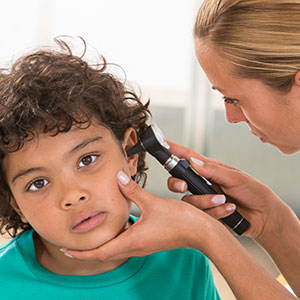If you have a little one with chronic ear infections, you may be wondering if it’s time for ear tubes. At OKC Pediatric ENT, our team knows that parents worry. We will use our skills and know-how to determine what’s best for your child, and we will discuss all options with you.
In this guide, our Oklahoma City ENT doctors will answer a few of your questions about ear infections and ear tubes. At the outset, we’d like to say that we prefer to manage the situation without surgery if possible. Ear tubes are only considered when other solutions aren’t working.
 How Many Ear Infections Before Tubes in Toddlers?
How Many Ear Infections Before Tubes in Toddlers?
We are often asked about the number of ear infections that a little one must have before ear tubes. In a six month period, three distinct episodes are significant. Three is a big number in the life of a 10 month old with ear infections. For that matter, it’s a big number in the life of a two year old. In a year, four or more episodes are significant.
Frequency is just one measure when pediatric ENT doctors are deciding whether a child needs ear tubes. Even if there is no bacterial or viral cause, persistent fluid buildup cannot be ignored. Chronic infections that don’t respond to antibiotics are especially troubling. Another danger is tearing or perforation of the eardrum due to chronic suppurative otitis media.
In many cases, hearing loss is a deciding factor. Ear tubes can quickly reverse the problem and ensure proper speech and behavior development.
Why Do They Put Tubes in Ears?
Since babies and toddlers are still developing, their natural tubes are often not big enough to be effective. Eustachian tubes connect each ear with the back of the throat. The resulting air flow freshens the ear and maintains the proper air pressure. Normal secretions in the ear are drained as well. If the Eustachian tubes are too small, they get blocked by natural fluids and pressure builds up. This invites viruses and bacteria to attack. Tympanostomy tubes can be surgically inserted to drain the fluid and reduce the chances of recurring ear infections.
What are Ear Tubes?
During a brief surgical procedure, tiny hollow cylinders are inserted into the child’s eardrum. This allows air to circulate and ensures that fluid can drain. After six to eight months, the tube will drop out, and the holes will seal up on their own. If a tube doesn’t fall out on time, it may be necessary for the surgeon to remove it. Occasionally an ear tube will fall out too soon, and the doctor may recommend replacement.
Over half a million children have this operation every year. It is most common among one to three year olds.
Pros and Cons of Ear Tubes
A happier child is almost guaranteed, and that’s a relief to parents. For starters, ear infection risk is greatly reduced. The tubes eliminate the chances of a blocked Eustachian tube after ear infection. Less pain means fewer sleep problems and better behavior. Almost immediately, hearing is improved. This, in turn, allows speech to improve.
The main risks are associated with the need for anesthesia. This is a common operation and few children have reactions. If they do, an entire medical team is watching over them for any sign of distress. Your Pediatric ENT doctor will discuss all risks with you.
Schedule an Appointment
Concerned parents are invited to contact OKC Pediatric ENT for a consultation about their child’s ear infections. We can put your mind at ease about this common problem and discuss the best strategy for improving your child’s health.

